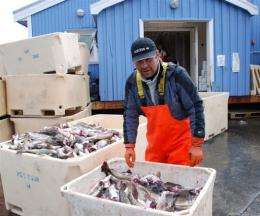Greenland shark may become new source of biofuel

The Greenland shark, one of the largest species of sharks, is a nuisance to fishermen and its meat is toxic to humans, but researchers now hope the flesh can be used to create a biofuel for Inuits.
Native to the cold Arctic waters, thousands of the sharks get caught and die in fishermen's nets off Greenland every year. The beasts -- which can be compared to the Great White Shark in size at seven metres (23 feet) and can weigh up to a tonne -- are thrown back into the sea.
But at the Arctic Technology Centre (ARTEK) in Sisimiut in western Greenland, researchers are experimenting with ways of using the animal's oily flesh to produce biogas out of fishing industry waste.
"I think this is an alternative where we can use the thousands of tonnes of leftovers of products from the sea, including those of the numerous sharks," says Marianne Willemoes Joergensen of ARTEK's branch at the Technical University of Denmark.
Joergensen, in charge of the pilot project based in the Uummannaq village in northwestern Greenland, says the shark meat, when mixed with macro-algae and household wastewater, could "serve as biomass for biofuel production."
"Biofuel is the best solution for this kind of organic waste, which can be used to produce electricity and heating with a carbon neutral method," she said.
Biofuel based on sharks and other sea products could supply 13 percent of energy consumption in the village of Uummannaq with its 2,450 inhabitants, according to estimates.
The project could help the many isolated villages on the vast island to become self-sufficient in terms of energy.
Joergensen plans to run tests next year at an organic waste treatment plant in a project financed by the EU in Uummannaq, using shark meat mixed with wastewater and macro-algae to create a fish mince that can be used to produce biogas.
In Uummannaq, the Greenland shark represents more than half of the waste disposed of by the local fishermen.
"Entire trawlers are sometimes full of sharks and they are caught everywhere, especially off the east and west of Greenland, to the fishermen's great dismay," says Bo Lings who used to work on a big trawler.
"It's a large predator that devours fish, squid, seals and other marine life, and it also ruins the lines and nets of the halibut fishermen," adds Leif Fontaine, the head of Greenland's fishing and hunting association.
Fishing is Greenland's biggest export industry, with halibut its second-biggest product after shrimp.
The shark, which Inuits once hunted for its razor-like teeth that they used to make knives and for its liver oil that was used to light homes, has "become a problem for the environment."
"There are too many sharks in the nets and they just get thrown back," explains one of ARTEK's founders, engineer Joern Hansen.
Greenlanders usually dispose of fishing industry waste and household wastewater by throwing them into the sea.
In the Uummannaq municipality, over half of all the waste contains large amounts of fat that are suitable for producing biofuels in the future, and Hansen says that waste should be put to good use.
"All you have to do is set up installations in the fish processing centres, like in Ilulissat where the shrimp and halibut plant is partly heated by fish waste," he said.
Aksel Blytmann, a consultant at Greenland's fishing and hunting association, says the shark could turn out to be an "unexpected energy source."
He explained that Uummannaq once paid a 200-Danish-kroner (26-euro, 38-dollar) reward to fishermen for a shark heart in order to keep their numbers down. Other municipalities in the northwestern and western parts of Greenland still continue this practice, he said.
The species "swarms in the Arctic waters and is not in danger of extinction," Blytmann claimed.
But the International Union for the Conservation of Nature disagrees, as does the Danish branch of the Worldwide Fund for Nature.
Anne-Marie Bjerg, a WWF specialist on ocean mammals, says the shark-for-biofuel project "is not a good idea, not at all," and wants to see other sustainable energy projects undertaken instead.
"We know very little about the Greenland shark, which lives in a limited geographic zone, the Arctic," she said.
Contrary to the fishermen's own accounts, she insisted the mammal "does not pose big problems to Greenland's fishing industry."
"We are opposed to the commercial use of marine mammals, such as the Greenland shark, which is not universal and whose population size is unknown," she said.
(c) 2009 AFP
















